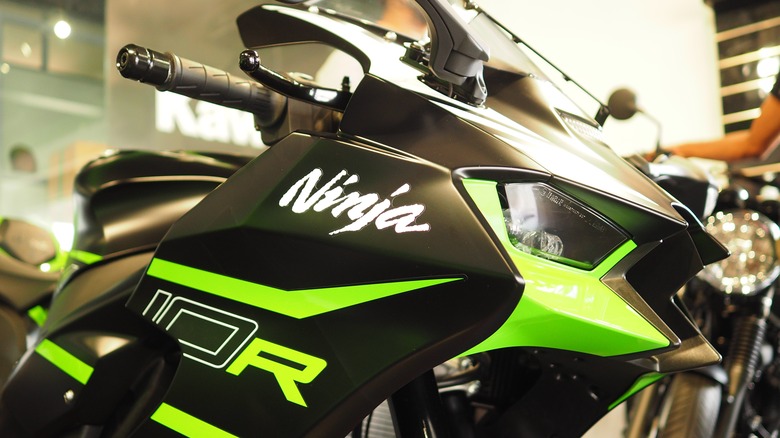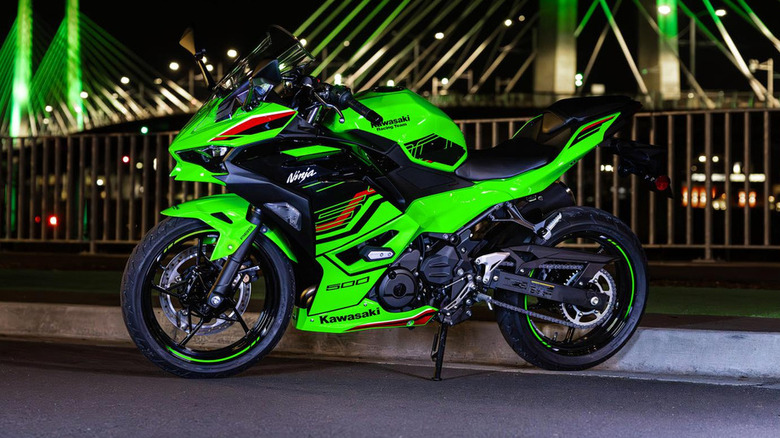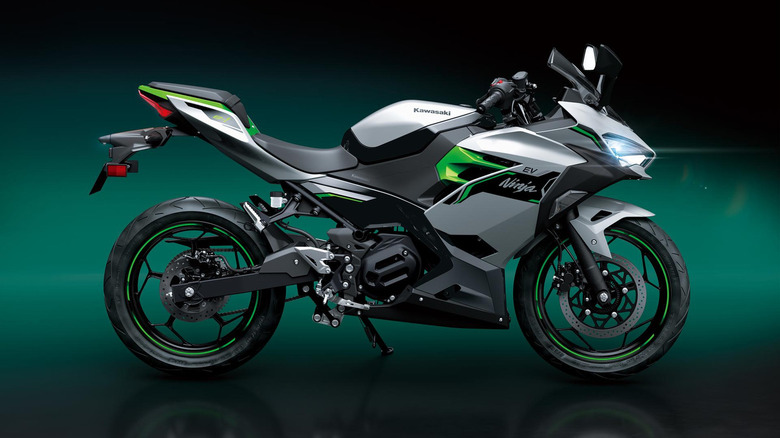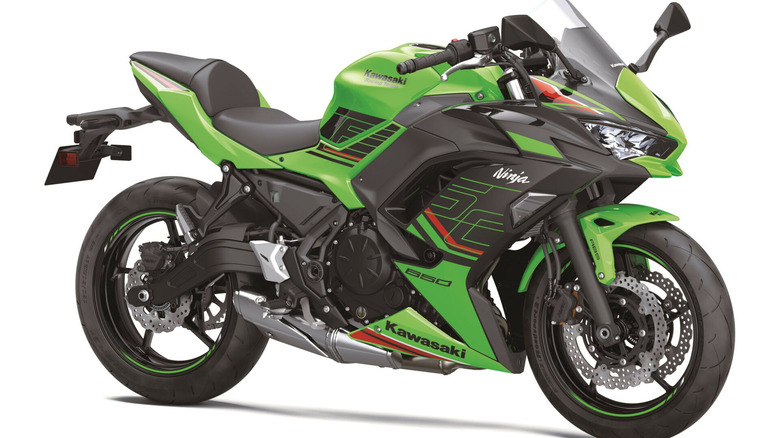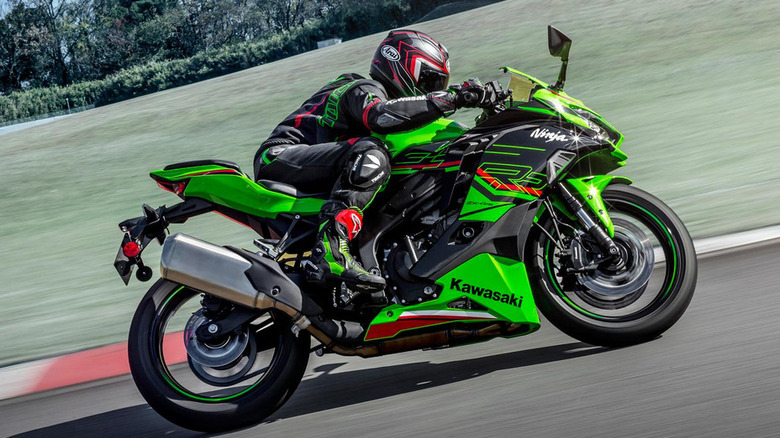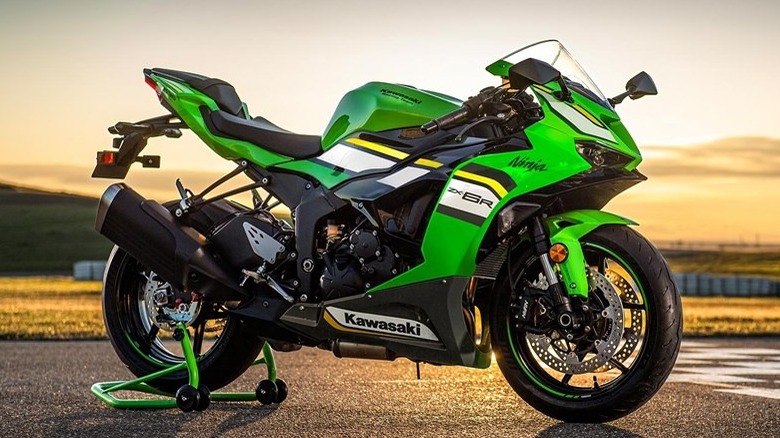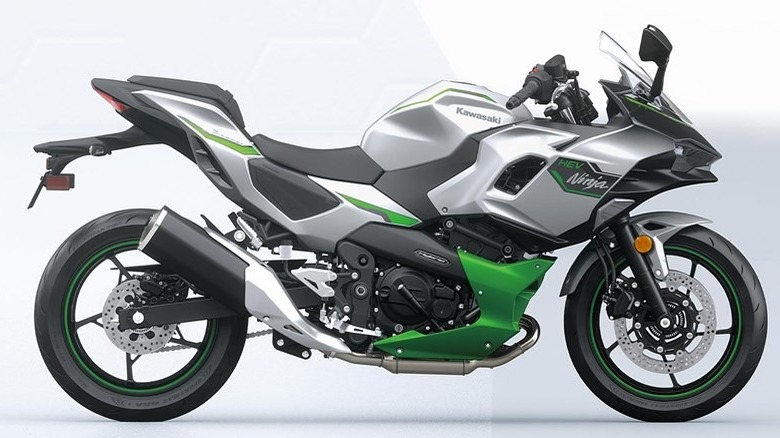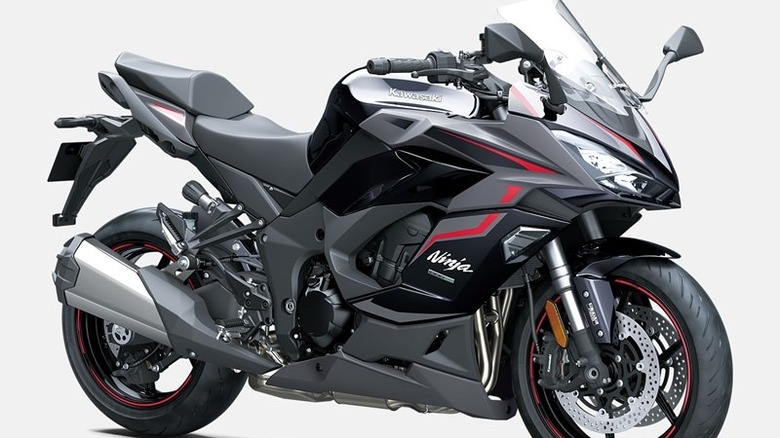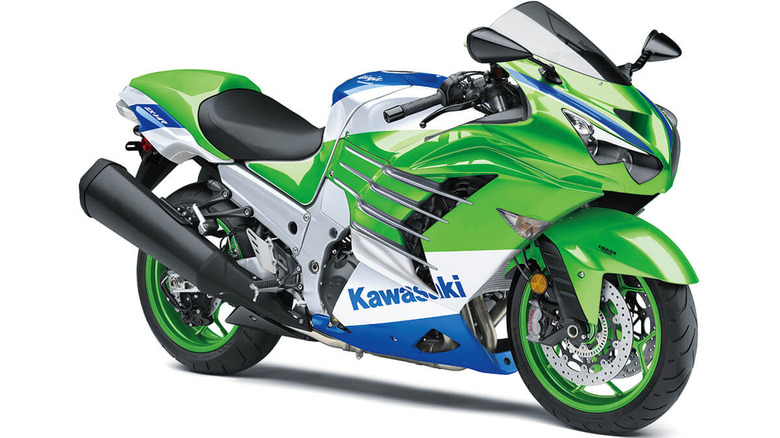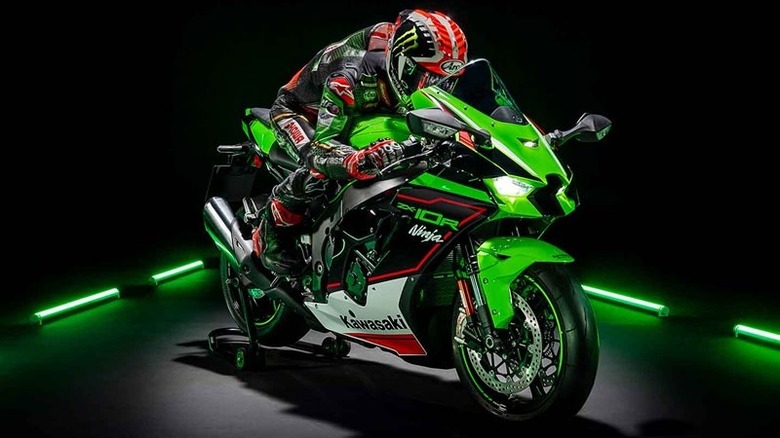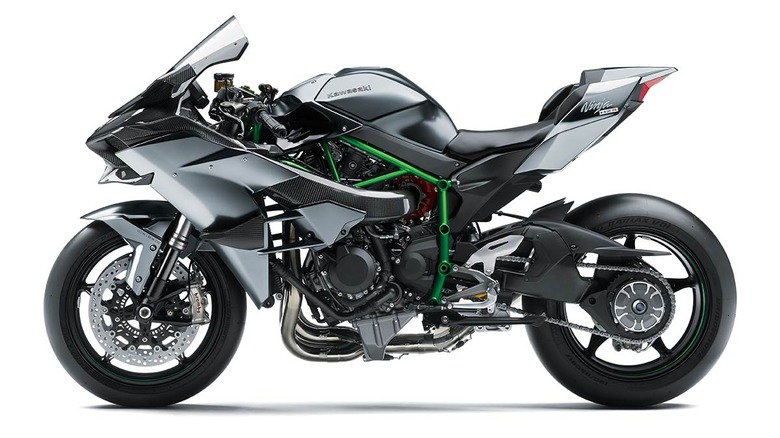Every Kawasaki Ninja You Can Buy In 2024, Ranked From Cheapest To Most Expensive
Kawasaki has long been a major player in the sportbike game. What began as an industrial concern in the late 19th century grew into one of the most legendary motorcycle producers ever. One of the four big Japanese firms that created and popularized supersport performance bikes, Kawasaki, is going on a half-century of racing development.
Some rare Kawasaki bikes have become the most sought-after motorcycles in the collector's market. And that should come as no surprise. Kawasaki's contribution to motorcycles is nothing short of influential. Perhaps the most influential bike they've ever put on the street is the vaunted Ninja.
Honda kickstarted the superbike craze with the CB750, and the other four big manufacturers quickly followed. By the debut of Kawasaki's 1984 GPz900R, faster and leaner was the name of the game. The first bike to earn one of the most famous names in motorcycling, the Ninja GPz900R came with a 16-valve, liquid-cooled four-cylinder that made 108 horsepower and packed it into a 546-pound package; the inaugural Ninja began an arms race in the cycling world. It was the progenitor of modern sport bikes, and its impact has been lasting, to say the least.
The modern Ninja has born an entire line of bikes no longer relegated to the 600 and 1,000 cc displacements. No longer just for knee-dragging handling and mind-bending speed, the 2024 Ninja has something for everyone, from the beginner rider to the weekend track enthusiast to the rider who just needs the fastest thing around in their garage.
This year marks the 40th anniversary of the Ninja. We decided to take a comprehensive look at all the bikes honored with the Ninja nameplate.
Ninja 400 & Ninja 500 -- $5,299
New riders with good mentors used to be cautioned against starting on a sportbike. They were fast and twitchy, and a handful of throttle was a lot to handle. In recent years, manufacturers have explored smaller, more manageable bikes with sportbike aesthetics and performance. Kawasaki is acutely familiar with this phenomenon. When Honda, Suzuki, and Yamaha were focused on 600s and 1000s, its Ninja 250 and 500 offerings gave new riders a stepping stone into sport riding.
That philosophy lives on in the least expensive Ninjas in the 2024 lineup. Kawasaki offers two bikes in the sub-600 displacement range: the Ninja 400 and Ninja 500. Curiously, the bikes are both provided at the starting price of $5,299. Even stranger, despite the monikers, only 52 cubic centimeters separate the 399 cc 400 from the 451 cc 500.
The answer is that Kawasaki will discontinue the 400 model while easing the slightly more powerful 500 into its affordable beginner bike slot. The result is a 51 horsepower parallel twin in a 379-pound body with a 30.9-inch seat height.
Small-displacement Ninjas could be called beginner bikes because they are lightweight and carry a relatively small displacement. However, a lot of action happens between 25 and 65 miles per hour, and who amongst us uses the entire powerband of a liter bike? The entry-level Ninjas are just that — entry-level. However, considering how prices for machines have shot up in recent years, potential buyers could do much worse.
Ninja e-1 -- $7,899
Next on Kawasaki's price hierarchy is the Ninja e-1. As the automotive world continues to turn to electric vehicles, Kawasaki got in on the action with its first full-size EV bike. Priced at $7,899, the e-1 is another indicator that the Ninja name is morphing into its own sub-brand.
Despite lacking an internal combustion engine, the e-1 gets its juice from a pair of lithium-ion batteries housed in what, in the olden days, we called the "gas tank." Even with the Ninja badge, the e-1 should be considered a commuter solution rather than a performance vehicle. With a maximum range of 41 miles and a max speed of 55 miles per hour, the e-1 is not exactly in Yamaha R1 territory.
The e-1 might look like a track machine, but it is decidedly not. The electric powertrain removes the need for a clutch, nixing the idea of gears as a single-ratio transmission delivers power to the wheel.
It's interesting to see a major manufacturer slot an EV into its performance vehicle lineup. While the e-1 may be a major outlier in a family that includes the incomparable Ninja H2R (more below), it suggests a certain flexibility in Kawasaki's future vision. Is there room for a sport-styled e-commuter? Only time will tell.
Ninja 650 -- $8,299
In the past, a 600 cubic centimeter plus displacement sport bike with the Ninja name would be expected to pack a screaming inline four-cylinder. Not so for the 2024 Ninja 650. Instead, the parallel-twin configuration of the 400 and 500 provides the power. Coupled with aggressive styling, an upright set of handlebars, a relatively comfortable riding position, and the bells and whistles of modernity, including ABS, smartphone connectivity, traction control, and three adjustable riding modes, the 650 is the very picture of middleweight.
Competent without being overpowering, the 650 has 67 horsepower — more than enough, but a long shot from the 120+ that has come to be expected from middleweight sportbikes. One of the advantages of the parallel twin is its torquey power delivery. With nearly 50 pound-feet, the 650 is nicely balanced. It's a bike a beginner can learn on, and an expert can strive to master.
The 2024 Ninja 650 represents what a sportbike made for the road can be. Sure, there's an allure to the 200-horsepower-liter bikes, but most riders aren't screaming down the track on the weekends. They are taking a bike to work or on a weekend trip. Sportbike conjures images of scrunched-up riding positions and 17,000 RPM red lines. The Ninja 650 might be better imagined as a sporty bike with plenty of competent fun without getting too out of hand.
Ninja ZX-4R -- $9,399
The Ninja ZX-4R is the first entry on this list that hearkens back to the original concept of the Ninja — a track machine with turn signals. Don't let the relatively small displacement fool you; this Ninja earns its R designation.
Starting at $9,399, the ZX-4 is available in a quarter of designations: the ZX-4R ABS, ZX-4RR ABS, ZX-4RR KRT Edition ABS, and the 40th-anniversary edition ABS. The last two are mere cosmetic upgrades, with the 40th-anniversary edition recalling the paint schemes of the '90s. The $500 difference between the R and the $9,899 RR constitutes suspension and shifter upgrades for those interested in track weekends, including a bi-directional quick shifter and
With 76 horsepower and 26.5 pound-feet of torque, the 399 cc inline four-cylinder is far more in line with Ninjas of the past than the other small-displacement bikes on this list. The 15,000 RPM redline alone should tell you what you need to know about Kawa's vision for the ZX-4R.
Experienced riders might balk at Kawasaki's commitment to racey, small-displacement bikes, but the ZX-4R is plenty of bike without being unforgiving. This isn't the bike for the experienced track rider, but it's a great stepping stone for someone who wants to dip a toe in the performance world without flipping the bike over with a blip of the throttle, not to mention lighter or smaller riders who aren't comfortable on the big race machines.
Ninja ZX-6R -- $11,399
The years might have changed Kawasaki's approach to the Ninja, but the mainstay of the line, the respected ZX-6R, retains an honored place. Is it still a Ninja? Let's see. 636 cubic centimeter in-line four-cylinder? Check. North of 120 horsepower? Check. One hundred twenty-two, to be precise. Aggressive riding position? Check. Wild Kawasaki green paint job? Double check. It's a Ninja, alright.
Since 1995, the ZX-6R has been Kawasaki's premier middleweight sportbike. Once upon a time, the 600 class was the focus of the sportbike world. While the sixers may not take center stage anymore, the ZX-6R remains wildly competent.
It is marginally accepting of new or inexperienced riders while retaining a white-knuckle capability. Still, Kawasaki has kept up to date with the Ninja 6. This shows in the updated dash screen, advanced riding modes, customizable traction control and power, and updated cams and headers.
The 2024 iteration of the world's favorite superbike is a worthy continuation of a worthy line. Plenty of bike for an experienced rider to enjoy for a long time, it represents the stepping stone that separates the beginner bikes from the 1,000 cc monsters. At $11,399, it costs what one of those big boys did back in the beginning of the century, but that's how it is going. It's a better bike for it.
Ninja 7 Hybrid -- $12,499
The legendary R6 was discontinued in favor of the new Yamaha YZF-R7. Fortunately, Kawasaki has kept the ZX-6R alive, but that's not to say it can't dabble in the 700 cc department. What sets the Kawa apart is the fact that it's a hybrid.
If the e-1 piqued your interest until you saw the performance numbers, the Ninja 7 Hybrid may be more your speed. As the name suggests, a hybrid gas/electric system powers the Ninja 7, and it's something like getting (or at least seeking) the best of both worlds. The name is a misnomer, however. This bad boy has a 451 cc internal combustion parallel twin supplemented by an electrical traction motor powered by a 48-volt lithium-ion battery. The result, Kawasaki claims, is liter bike acceleration in a manageable and fuel-efficient package.
The styling is reminiscent of Kawasaki's Versys, with an upright seating position, flexed handlebars, and street-fighter-style fairings. The 7 Hybrid is another peek into Kawasaki's future view. Its 2024 Ninja lineup includes an all-electric bike along with a hybrid. Is this a wave of the future? Either way, this bike should grab the attention of anyone interested in the near future of cycling.
Ninja 1000SX -- $13,699
Think of the Ninja SX1000 as Kawasaki's nod to the fact that actual human beings ride its sportbikes. Note that there is no R in the designation for what could, in a closely parallel universe, be called a sport-tourer. While the Ninja name is reserved primarily for pure sportbikes, Kawasaki's current lineup indicates some open-mindedness regarding the line. While the 1000SX offers the power and performance of a sportbike, it was definitely designed with long rides in mind.
Kawasaki classes the 1000SX as a sport bike along with the 7 Hybrid, 650, 400, and 500 rather than a supersport or hypersport. With 140 horsepower and 82 pound-feet of torque out of the 1,000 cc inline four, there is plenty of power for any highway. The SX doesn't stop there; it includes a plethora of gizmos and gadgets designed to make rides as smooth and comfortable as possible.
Along with available hard luggage accessories, the SX aims to be king of the highway with traction control, integrated riding modes, ABS, cruise control, smartphone connectivity, quick shifting, a slipper clutch, and electronic throttle valves. Kawasaki seems to have pulled out all the stops to deliver a sport-touring experience a little less visceral, but no less enjoyable, than one might find with its super or hypersport offerings.
Ninja ZX-14R -- $16,599
The ZX-14R takes us to the largest displacement bike in Kawasaki's supersport stable. The speed wars of the 90s and early aughts pushed motorcycles further than they ever went with the likes of Honda's Blackbird, Suzuki's Hayabusa, and the ZX-14R. That legacy lives on in the curved fairings of Kawa's beefiest bike.
This bike is no highway cruiser; that role is reserved for the 1000SX. The ZX-14R used to be the fastest bike in Kawasaki's lineup before the arrival of the H2. While past iterations have leaned into power cruising, the 2024 is a drag-strip demon with an attitude.
With its 1,441 cubic centimeter in-line four cylinder engine making an insane 207 horsepower and 117 pound-feet of torque, this is not a bike for the beginner or the faint of heart. It's a street weapon for expert riders with a tight grip on the handlebars. If you want Kawasaki's biggest supersport, look at the ZX-14R.
Ninja ZX-10R -- $17,799
Ah, the literbike. Once the pinnacle of the sportbike world, it may be outstripped by the power and performance competition raging between the big four, but it remains a key contender. Kawasaki's ZX-10R has been around since 2004. Slated to duke it out with the likes of the Honda CBR1000RR, Yamaha R1, and Suzuki GSX-R 1000, it more than held its own.
Twenty years on, the 2024 ZX-10R remains a celebrated member of the Ninja family. Like its bigger sibling, the ZX-14R, the 998 cc in-line four-cylinder powerplant cracks the 200 horsepower mark with 204 and 82 pound-feet of torque.
One of the new changes in the 2024 model is the inclusion of aerodynamic winglets — smaller versions of what you might see on MotoGP racers — to improve drag resistance and increase downforce. Everything about the ZX-10R is about getting better performance, one way or another. The liter Ninja is a weapon on the street or the track that begs riders to drag a knee.
Ninja H2 -- $57,500
The first Kawasaki to earn the H2 moniker was the Mach IV back in the 1970s. But it was known by another name: the Widowmaker. Its peaky two-stroke power alarmed riders and required a steady hand at the throttle. The current iteration of the H2 carries on that legacy. It is an absolutely insane motorcycle built to put a period on the power wars.
Forget sport, forget supersport. Kawasaki classes the H2 as a hypersport machine, and it's easy to see why. Kawasaki engineers started at the very beginning to develop a supercharged, 998 cc engine nestled in a trellis frame and governed by state of the art systems meant to keep wheels on the ground and riders in the seat.
The H2 comes in three flavors: the H2, the SX, and the H2R. The SX is akin to the 1000 SX in that it is geared toward sport-touring and the associated features like cruise control and assist systems. It also produces a relatively sane 200 horsepower. Shell out for the H2R, and those comfort features go out the window. The baddest Ninja on the planet makes 326 horsepower. That's not a typo; that number begins with a "3." So far, nothing comes close to putting more power to the street in a production motorcycle.
It goes without saying that H2R is not for the inexperienced or incompetent. However, if the fastest production bike available is on your bucket list, the H2R belongs in your garage.
